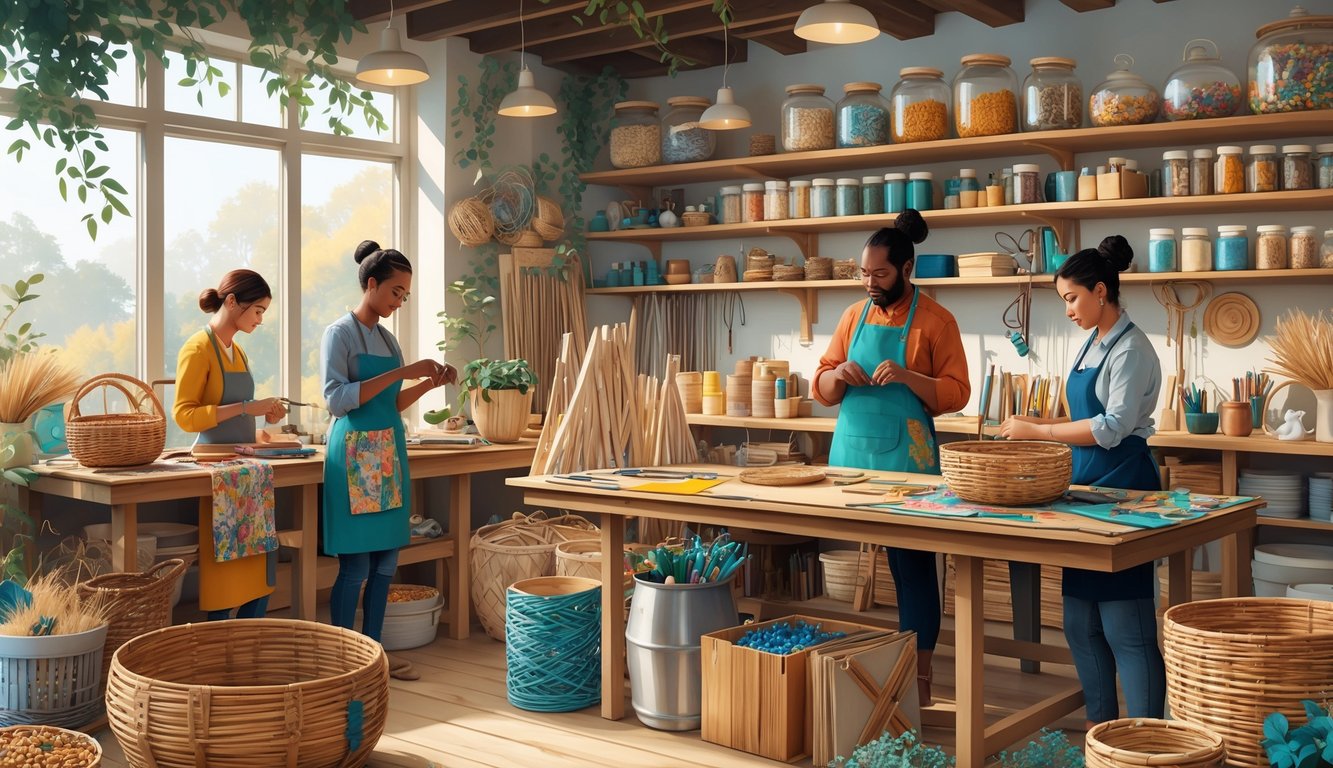
Sustainability in Crafting Communities
Everyone’s suddenly swapping supplies instead of hoarding. Recycled fabric drives, people making wreaths out of leaves, and garages full of “future projects” that never actually get made. How did that happen?
Community Sharing Initiatives
Swapping and sharing isn’t just for moving day. I’m in this Facebook group—people list leftover wool, glass jars, linen, clay. Someone always wants it, and bam, less waste. Why do I have so many buttons in a jar anyway?
Here’s what actually happens:
- Swaps/lending libraries: Someone drops off a sewing machine for the next person.
- Online exchanges: Old packing material everywhere.
- Community boards: Pins holding up baggies of zippers, cork, glitter, even a busted knitting loom. Someone wanted that.
Glitter never dies, it just moves around. Some folks use time banks—trade an hour of sewing for a paper bead kit. Sustainability gets weird.
Workshops Promoting Green Practices
Workshops are chaos now. That quilting one last spring? Two people argued over which denim patch looked more “authentic,” and then a demo of compostable glue. Not what I expected. Suddenly, I’m learning that linen offcuts and nettle twine make brag-worthy table runners.
Rules are out the window. You show up for macramé, but instead:
- Wall lists like “Zero Waste Craft Ingredients” (felt scraps, leaves, glass shards).
- Demos with no symmetry—some guy swears dried orange peels beat pom-poms.
- People ask, “How much secondhand is too much?” and then start swapping stain remover recipes.
One instructor always brings up local fair trade wool or recycled polyester. Says it “eases her conscience.” I just want something that survives the wash. Not romantic, but you leave with weird tips and zero extra plastic.
Adapting Packaging to Material Constraints
Packaging falls apart fast—literally and metaphorically—when you can’t get what you need. Suddenly, the outside’s as much of a headache as what goes in. Maybe it’s good, forces people to try stuff they’d never bother with, even if you’re just trying to put together a kit and the tape sticks to itself.
Innovative Eco-Friendly Packaging Ideas
Compostable wrappers are everywhere—cornstarch film clinging to bottles, cardboard made of pressed leaves, mushroom foam jammed into boxes. Fungi are having a moment. Glass jars vanish fast, people line shelves with old jam jars, peanut butter tubs—most folks just toss those, but now they’re precious. Biodegradable plastics are a gamble; I had a roll melt in my hands, but another batch lived in a soggy basement for a week.
Recycled paperboard is a big deal, even if the color’s never right. Some people cut up holiday cards for padding—doesn’t look pro, but it’s got personality. Reusable cloth pouches show up all the time, and then get lost in bags forever. I tried folding old t-shirts for padding, but got distracted reading the logos.
| Material | Availability | Weird Issue |
|---|---|---|
| Glass | Low | Always missing lids |
| Mycelium | Moderate | Smells weird, looks cool |
| Bioplastic | Unreliable | Melts sometimes, that’s it |
Minimalist Packaging Approaches
Minimalist packaging—trend or just out of bubble wrap? Who knows. Sometimes it’s just a thin sleeve, no filler, a sticker to seal it. Packages rattle and, weirdly, I want to open them faster. Expensive stuff still gets layers, except my friend’s candle set came wrapped in a phone book page. Who still has a phone book?
People brag about using only what’s needed—one roll of tape, a recycled box, that’s it. Extra crumpled paper feels decadent now. I used a rubber band as my entire packaging once, not on purpose, just grabbed it. Ink-stamped logos look cool, but if you’re in a hurry or spill coffee, they smear everywhere. Half the time I don’t know if I’m clever or just desperate.



